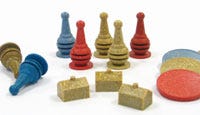Eliminating the need for predrying and coming to market with 42 products under patent, JER Envirotech is transitioning from research and development to sales and marketing of wood-plastic composite (WPC) panel boards and compounded pellets that it hopes will move WPC beyond decking.
October 1, 2007
Eliminating the need for predrying and coming to market with 42 products under patent, JER Envirotech is transitioning from research and development to sales and marketing of wood-plastic composite (WPC) panel boards and compounded pellets that it hopes will move WPC beyond decking.
|
Founded in 1997, JER Envirotech Ltd. (Delta, BC) partnered with the National Research Council of Canada and the Industrial Materials Institute for research, which 10 years on, is being commercialized. According to CEO and President Ed Trueman, the payoff has come, with growth that’s explosive, albeit from a small base, as JER is on pace for its 2007 fiscal fourth quarter to generate more revenue than the company earned in all of 2006. The company went public in 2004 and over the last three years has invested some $10 million in production to support such sales.
“For the transition from an R&D, startup kind of a company,” Trueman explains, “we had to bolt on the kind of talent in relatively short order.” That talent came in August, when JER announced the four executive-level appointments en masse: chief financial officer, chief technology officer, VP of manufacturing, and VP global sales and marketing, pulling talent from companies like Taiga Building Products, DuPont, and specialty compounder AlphaGary, which Trueman himself left in December 2006.
Panels and pellets
Trueman says the company applies rice hulls and wood fiber as fillers, initially using virgin polypropylene as the carrier, but recently expanding into virgin and recycled polyethylene and polystyrene. At its plant in British Columbia, JER has three lines running panel boards and two dedicated to compounding WPC pellets. The company has partnered with Entek Extruders (Lebanon, OR) to build custom lines from the ground up, leaning on that company’s experience in handling harsh materials to process the rice hulls, which can contain up to 20% silica (for more on Entek, see July 2006 Spotlight).
The panel-board, which can be color matched, comes in thicknesses from 3 to 10 mm, widths of 4 ft, and customizable lengths, with one customer receiving 4-by-17-ft panels. At thicker levels, the panel board can actually be used in structural applications, including subfloors, providing a natural moisture barrier, or it can be laminated for decorative flooring and moisture-resistant signage. “With WPC, you’re encapsulating the fiber with polymer,” Trueman explains, “the polymer is your barrier.” Trueman adds that it’s also possible to engineer in other functions including mold and UV resistance via additives.
MPW asked Trueman if the company avoids predrying of its fiber via outgassing vents on the extruder, and while he declined to offer specifics, according to JER’s investor newsletter, the end product is dried via a patented chemical reaction that occurs in the production process. Compared to mechanical drying, JER believes a chemical route offers several benefits, including lower costs, simplicity, and less equipment, in addition to fire-safety benefits of not drying fine, flammable particulates.
Injection molding opportunity
Beyond pushing the technology that’s behind the boards and pellets, JER plans to promote it in markets and applications that currently use highly-filled thermoplastics, but not WPC. “The team I’ve constructed is used to developing materials that are a non-traditional penetration,” Trueman says. Currently the company has applications in appearance and nonappearance components for automotive, consumer goods, leisure products, and furniture markets. Most of these products are injection molded, applying JER’s precompounded WPC pellets and tapping huge growth potential beyond the relatively saturated extruded-profile sector.
According to market watcher Principia Consulting (Exton, PA), projected demand for injection molded wood-plastic composites will experience 70% average annual growth, reaching a market size of more than $350 million in 2008. Potential business comes in building products as well as packaging, lawn and garden, and housewares.
As part of its introduction to the market, and a further indication that it’s now in full marketing mode, JER has highlighted the sustainability aspect of its material, which combines waste wood and fiber products with waste plastic for durable goods. “[The materials] give our customers an option,” Trueman says. “The message to their customer base, is the advent of a new generation of materials that are concerned about the environment.”
About the Author(s)
You May Also Like



